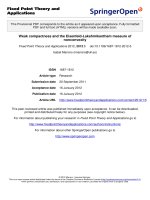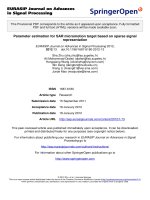Báo cáo toán học: " Sharp bounds for Seiffert mean in terms of root mean square" pot
Bạn đang xem bản rút gọn của tài liệu. Xem và tải ngay bản đầy đủ của tài liệu tại đây (154.18 KB, 15 trang )
This Provisional PDF corresponds to the article as it appeared upon acceptance. Fully formatted
PDF and full text (HTML) versions will be made available soon.
Sharp bounds for Seiffert mean in terms of root mean square
Journal of Inequalities and Applications 2012, 2012:11 doi:10.1186/1029-242X-2012-11
Yu-Ming Chu ()
Shou-Wei Hou ()
Zhong-Hua Shen ()
ISSN 1029-242X
Article type Research
Submission date 19 September 2011
Acceptance date 17 January 2012
Publication date 17 January 2012
Article URL />This peer-reviewed article was published immediately upon acceptance. It can be downloaded,
printed and distributed freely for any purposes (see copyright notice below).
For information about publishing your research in Journal of Inequalities and Applications go to
/>For information about other SpringerOpen publications go to
Journal of Inequalities and
Applications
© 2012 Chu et al. ; licensee Springer.
This is an open access article distributed under the terms of the Creative Commons Attribution License ( />which permits unrestricted use, distribution, and reproduction in any medium, provided the original work is properly cited.
Sharp bounds for Seiffert mean in
terms of root mean square
Yu-Ming Chu
∗1
, Shou-Wei Hou
2
and Zhong-Hua Shen
2
1∗
Department of Mathematics, Huzhou Teachers College,
Huzhou 313000, China
2
Department of Mathematics, Hangzhou Normal University,
Hangzhou 310012, China
∗
Corresponding author: chuyuming2005@yaho o.com.cn
Email addresses:
S-WH:
Z-HS:
Abstract
We find the greatest value α and least value β in (1/2, 1) such
that the double inequality
S(αa+(1−α)b, αb+(1−α)a) < T(a, b) < S(βa+(1−β)b, βb+(1−β)a)
1
holds for all a, b > 0 with a = b. Here, T (a, b) = (a−b)/[2 arctan((a−
b)/(a + b))] and S(a, b) = [(a
2
+ b
2
)/2]
1/2
are the Seiffert mean
and root mean square of a and b, respectively.
2010 Mathematics Subject Classification: 26E60.
Keywords: Seiffert mean; root mean square; power mean; in-
equality.
1 Introduction
For a, b > 0 with a = b the Seiffert mean T(a, b) and root mean square
S(a, b) are defined by
T (a, b) =
a − b
2 arctan(
a−b
a+b
)
(1.1)
and
S(a, b) =
a
2
+ b
2
2
, (1.2)
respectively. Recently, both mean values have been the subject of intensive
research. In particular, many remarkable inequalities and properties for T
and S can be found in the literature [1–14].
2
Let A(a, b) = (a+b)/2, G(a, b) =
√
ab, and M
p
(a, b) = ((a
p
+b
p
)/2)
1/p
(p =
0) and M
0
(a, b) =
√
ab be the arithmetic, geometric, and pth power means
of two positive numbers a and b, respectively. Then it is well known that
G(a, b) = M
0
(a, b) < A(a, b) = M
1
(a, b) < T (a, b) < S(a, b) = M
2
(a, b)
for all a, b > 0 with a = b.
Seiffert [1] proved that inequalities
A(a, b) < T (a, b) < S(a, b)
hold for all a, b > 0 with a = b .
Chu et al. [5] found the greatest value p
1
and least value p
2
such that the
double inequality H
p
1
(a, b) < T(a, b) < H
p
2
(a, b) holds for all a, b > 0 with
a = b, where H
p
(a, b) = ((a
p
+(ab)
p/2
+b
p
)/3)
1/p
(p = 0) and H
0
(a, b) =
√
ab
is the pth power-type Heron mean of a and b.
In [6], Wang et al. answered the question: What are the best possible
parameters λ and µ such that the double inequality L
λ
(a, b) < T(a, b) <
L
µ
(a, b) holds for all a, b > 0 with a = b? where L
r
(a, b) = (a
r+1
+b
r+1
)/(a
r
+
b
r
) is the rth Lehmer mean of a and b.
Chu et al. [7] proved that inequalities
pT (a, b) + (1 −p)G(a, b) < A(a, b) < qT (a, b) + (1 − q)G(a, b)
3
hold for all a, b > 0 with a = b if and only if p ≤ 3/5 and q ≥ π/4.
Hou and Chu [9] gave the best possible parameters α and β such that the
double inequality
αS(a, b) + (1 −α)H(a, b) < T(a, b) < βS(a, b) + (1 −β)H(a, b)
holds for all a, b > 0 with a = b.
For fixed a, b > 0 with a = b, let x ∈ [1/2, 1] and
f(x) = S(xa + (1 −x)b, xb + (1 − x)a ).
Then it is not difficult to verify that f(x) is continuous and strictly
increasing in [1/2, 1]. Note that f(1/2) = A(a, b) < T(a, b) and f(1) =
S(a, b) > T (a, b). Therefore, it is natural to ask what are the greatest value
α and least value β in (1/2, 1) such that the double inequality
S(αa + (1 − α)b, αb + (1 − α)a) < T (a, b) < S(βa + (1 − β)b, βb + (1 − β)a )
holds for all a, b > 0 with a = b. The main purpose of this article is to answer
these questions. Our main result is the following Theorem 1.1.
Theorem 1.1. If α, β ∈ (1/2, 1), then the double inequality
S(αa+(1−α)b, αb+(1−α)a) < T (a, b) < S(βa+(1−β)b, βb+(1−β)a) (1.3)
4
holds for all a, b > 0 with a = b if and only if α ≤ (1 +
16/π
2
− 1)/2 and
β ≥ (3 +
√
6)/6.
2 Proof of Theorem 1.1
Proof of Theorem 1.1. Let λ = (1+
16/π
2
− 1)/2 and µ = (3+
√
6)/6.
We first proof that inequalities
T (a, b) > S(λa + (1 −λ)b, λb + (1 − λ)a) (2.1)
and
T (a, b) < S(µa + (1 −µ)b, µb + (1 − µ)a) (2.2)
hold for all a, b > 0 with a = b .
From (1.1) and (1.2), we clearly see that both T (a, b) and S(a, b) are sym-
metric and homogenous of degree 1. Without loss of generality, we assume
that a > b. Let t = a/b > 1 and p ∈ (1/2, 1), then from (1.1) and (1.2) one
has
S(pa + (1 −p)b, pb + (1 − p)a) −T(a, b)
= b
[pt + (1 − p)]
2
+ [(1 − p)t + p]
2
2 arctan(
t−1
t+1
)
×
√
2 arctan(
t − 1
t + 1
) −
t − 1
[pt + (1 − p)]
2
+ [(1 − p)t + p]
2
. (2.3)
5
Let
f(t) =
√
2 arctan
t − 1
t + 1
−
t − 1
[pt + (1 − p)]
2
+ [(1 − p)t + p]
2
, (2.4)
then simple computations lead to
f(1) = 0, (2.5)
lim
t→+∞
f(t) =
√
2π
4
−
1
p
2
+ (1 − p)
2
, (2.6)
f
(t) =
f
1
(t)
{[pt + (1 − p)]
2
+ [(1 − p)t + p]
2
}
3
2
(t
2
+ 1)
, (2.7)
where
f
1
(t) =
√
2{[pt + (1 − p)]
2
+ [(1 − p)t + p]
2
}
3
2
− (t + 1)(t
2
+ 1). (2.8)
Note that
{
√
2{[pt + (1 − p)]
2
+ [(1 − p)t + p]
2
}
3
2
}
2
− [(t + 1)(t
2
+ 1)]
2
= (t −1)
2
g
1
(t), (2.9)
where
g
1
(t) = (16p
6
− 48p
5
+ 72p
4
− 64p
3
+ 36p
2
− 12p + 1)t
4
− 16p
2
(4p
2
− 4p + 3)(p −1)
2
t
3
+ 2(48p
6
− 144p
5
+ 168p
4
− 96p
3
+ 36p
2
− 12p + 1)
× t
2
− 16p
2
(4p
2
− 4p + 3)(p −1)
2
t + 16p
6
− 48p
5
+ 72p
4
− 64p
3
+ 36p
2
− 12p + 1, (2.10)
6
g
1
(1) = 4(12p
2
− 12p + 1). (2.11)
Let g
2
(t) = g
1
(t)/4, g
3
(t) = g
2
(t), g
4
(t) = g
3
(t)/6. Then simple computa-
tions lead to
g
2
(t) = (16p
6
− 48p
5
+ 72p
4
− 64p
3
+ 36p
2
− 12p + 1)t
3
− 12p
2
(4p
2
− 4p + 3)(p −1)
2
t
2
+ (48p
6
− 144p
5
+ 168p
4
− 96p
3
+ 36p
2
− 12p
+ 1)t − 4p
2
(4p
2
− 4p + 3)(p −1)
2
, (2.12)
g
2
(1) = 2(12p
2
− 24p + 2), (2.13)
g
3
(t) = 3(16p
6
− 48p
5
+ 72p
4
− 64p
3
+ 36p
2
− 12p + 1)t
2
− 24p
2
(4p
2
− 4p
+ 3)(p − 1)
2
t + 48p
6
− 144p
5
+ 168p
4
− 96p
3
+ 36p
2
− 12p + 1, (2.14)
g
3
(1) = 4(6p
4
− 12p
3
+ 18p
2
− 12p + 1), (2.15)
g
4
(t) = (16p
6
− 48p
5
+ 72p
4
− 64p
3
+ 36p
2
− 12p + 1)t
− 4p
2
(4p
2
− 4p + 3)(p −1)
2
, (2.16)
g
4
(1) = 12p
4
− 24p
3
+ 24p
2
− 12p + 1. (2.17)
We divide the proof into two cases.
7
Case 1. p = λ = (1 +
16/π
2
− 1)/2. Then equations (2.6), (2.11),
(2.13), (2.15), and (2.17) lead to
lim
t→+∞
f(t) = 0, (2.18)
g
1
(1) = −
4(5π
2
− 48)
π
2
< 0, (2.19)
g
2
(1) = −
2(5π
2
− 48)
π
2
< 0, (2.20)
g
3
(1) = −
2(7π
4
− 48π
2
− 192)
π
4
< 0, (2.21)
g
4
(1) = −
2(π
4
− 96)
π
4
< 0. (2.22)
Note that
16p
6
− 48p
5
+ 72p
4
− 64p
3
+ 36p
2
− 12p + 1 =
1024 − π
6
π
6
> 0. (2.23)
From (2.10), (2.12), (2.14), (2.16), and (2.23) we clearly see that
lim
t→+∞
g
1
(t) = +∞ (2.24)
lim
t→+∞
g
2
(t) = +∞ (2.25)
lim
t→+∞
g
3
(t) = +∞ (2.26)
lim
t→+∞
g
4
(t) = +∞ (2.27)
From equation (2.16) and inequality (2.23) we clearly see that g
4
(t) is
strictly increasing in [1, +∞), then inequality (2.22) and equation (2.27) lead
8
to the conclusion that there exists t
0
> 1 such that g
4
(t) < 0 for t ∈ (1, t
0
)
and g
4
(t) > 0 for t ∈ (t
0
, +∞). Hence, g
3
(t) is strictly decreasing in [1, t
0
]
and strictly increasing in [t
0
, +∞).
It follows from (2.21) and (2.26) together with the piecewise monotonicity
of g
3
(t) that there exists t
1
> t
0
> 1 such that g
2
(t) is strictly decreasing in
[1, t
1
] and strictly increasing in [t
1
, +∞).
From (2.20) and (2.25) together with the piecewise monotonicity of g
2
(t)
we conclude that there exists t
2
> t
1
> 1 such that g
1
(t) is strictly decreasing
in [1, t
2
] and strictly increasing in [t
2
, +∞).
Equations (2.7)–(2.9), (2.19), and (2.24) together with the piecewise monotonic-
ity of g
1
(t) imply that there exists t
3
> t
2
> 1 such that f(t) is strictly
decreasing in [1, t
3
] and strictly increasing in [t
3
, +∞).
Therefore, inequality (2.1) follows from equations (2.3)–(2.5) and (2.18)
together with the piecewise monotonicity of f(t).
Case 2. p = µ = (3 +
√
6)/6. Then equation (2.10) becomes
g
1
(t) =
(17t
2
+ 2t + 17)
108
(t − 1)
2
> 0 (2.28)
for t > 1.
Equations (2.7)–(2.10) and inequality (2.28) lead to the conclusion that
f(t) is strictly increasing in [1, +∞).
9
Therefore, inequality (2.2) follows from equations (2.3)–(2.5) and the
monotonicity of f(t).
From the monotonicity of f (x) = S(xa +(1−x)b, xb +(1−x)a) in [1/2, 1]
and inequalities (2.1) and (2.2) we know that inequality (1.3) holds for all
α ≤ (1 +
16/π
2
− 1)/2, β ≥ (3 +
√
6)/6 and a, b > 0 with a = b.
Next, we prove that λ = (1 +
16/π
2
− 1)/2 is the best possible para-
meter in (1/2, 1) such that inequality (2.1) holds for all a, b > 0 with a = b.
For any 1 > p > λ = (1 +
16/π
2
− 1)/2, from (2.6) one has
lim
t→+∞
f(t) =
π
2
−
1
p
2
+ (1 − p)
2
> 0. (2.29)
Equations (2.3) and (2.4) together with inequality (2.29) imply that for
any 1 > p > λ = (1 +
16/π
2
− 1)/2 there exists T
0
= T
0
(p) > 1 such that
S(pa + (1 − p)b, pb + (1 − p)a) > T (a, b)
for a/b ∈ (T
0
, +∞).
Finally, we prove that µ = (3 +
√
6)/6 is the best possible parameter in
(1/2, 1) such that inequality (2.2) holds for all a, b > 0 with a = b.
For any 1/2 < p < µ = (3 +
√
6)/6, from (2.11) one has
g
1
(1) = 4(12p
2
− 12p + 1) < 0. (2.30)
10
From inequality (2.30) and the continuity of g
1
(t) we know that there
exists δ = δ(p) > 0 such that
g
1
(t) < 0 (2.31)
for t ∈ (1, 1 + δ).
Equations (2.3)–(2.5) and (2.7)–(2.10) together with inequality (2.31) im-
ply that for any 1/2 < p < µ = (3 +
√
6)/6 there exists δ = δ(p) > 0 such
that
T (a, b) > S(pa + (1 −p)b, pb + (1 − p)a)
for a/b ∈ (1, 1 + δ).
Competing interests
The authors declare that they have no competing interests.
Authors’ contributions
Y-MC provided the main idea in this article. S-WH carried out the proof of
inequality (2.1) in this article. Z-HS carried out the proof of inequality (2.2)
in this article. All authors read and approved the final manuscript.
11
Acknowledgments
This research was supported by the Natural Science Foundation of China
under Grant 11071069, the Natural Science Foundation of Hunan Province
under Grant 09JJ6003 and the Innovation Team Foundation of the Depart-
ment of Education of Zhejiang Province under Grant T200924.
References
[1] Seiffert, HJ: Aufgabe β 16. Die Wurzel 29, 221–222 (1995)
[2] Neuman, E, S´andor, J: On the Schwab–Borchardt mean. Math. Pannon
14(2), 253–266 (2003)
[3] Neuman, E, S´andor, J: On the Schwab–Borchardt mean II. Math. Pan-
non 17(1), 49–59 (2006)
[4] Pahikkala, J.: On contraharmonic mean and Phythagorean triples.
Elem. Math. 65(2), 62–67 (2010)
[5] Chu, Y-M, Wang, M-K, Qiu, Y-F: An optimal double inequality between
power-typ e Heron and Seiffert means. J. Inequal. Appl. 2010, (Article
ID 146945), 11 (2010)
12
[6] Wang, M-K, Qiu, Y-F, Chu, Y-M: Sharp bounds for Seiffert means in
terms of Lehmer means. J. Math. Inequal. 4(4), 581–586 (2010)
[7] Chu, Y-M, Zong, C, Wang, G-D: Optimal convex combination bounds of
Seiffert and geometric means for the arithmetic mean. J. Math. Inequal.
5(3), 429–434 (2011)
[8] Liu, H, Meng, X-J: The optimal convex combination bounds for the
Seiffert’s mean. J. Inequal. Appl. 2011, (Article ID 686384), 9 (2011)
[9] Hou, S-W, Chu, Y-M: Optimal convex combination bounds of root-
square and harmonic root-square means for Seiffert mean. Int. J. Math.
Anal. 5(39), 1897–1904 (2011)
[10] Pillichshammer, F: On the root mean square weighted L
2
discrepancy
of scrambled nets. J. Complex. 20(5), 638–653 (2004)
[11] Petitjean, M: On the root mean square quantitative chirality and quan-
titative symmetry measures. J. Math. Phys. 40(9), 4587–4595 (1999)
[12] Nelsen, RB: Proof without words: the harmonic mean-geometric mean-
arithmetic mean-root mean square inequality. Math. Mag. 60(3), 158–
158 (1987)
13
[13] Abul-Magd, AY, Simbel, MH, Farag, MYH: Volume integrals and root-
mean-square radii of the optical potential. Canad. J. Phys. 58(8), 1230–
1237 (1980)
[14] Kamat, AR: On the mean successive difference and its ratio to the root
mean square. Biometrika 40, 116–127 (1953)
14









